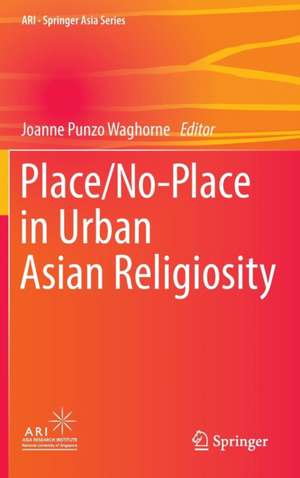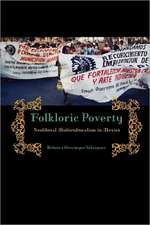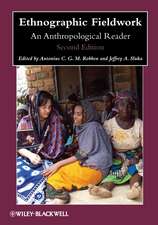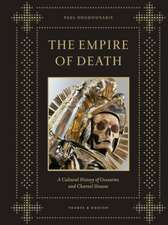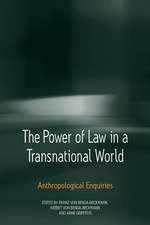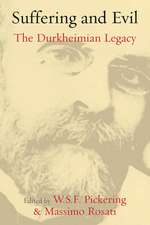Place/No-Place in Urban Asian Religiosity: ARI - Springer Asia Series, cartea 5
Editat de Joanne Punzo Waghorneen Limba Engleză Hardback – 26 iul 2016
| Toate formatele și edițiile | Preț | Express |
|---|---|---|
| Paperback (1) | 385.08 lei 6-8 săpt. | |
| Springer Nature Singapore – 31 mai 2018 | 385.08 lei 6-8 săpt. | |
| Hardback (1) | 392.37 lei 6-8 săpt. | |
| Springer Nature Singapore – 26 iul 2016 | 392.37 lei 6-8 săpt. |
Preț: 392.37 lei
Nou
Puncte Express: 589
Preț estimativ în valută:
75.08€ • 78.59$ • 62.49£
75.08€ • 78.59$ • 62.49£
Carte tipărită la comandă
Livrare economică 31 martie-14 aprilie
Preluare comenzi: 021 569.72.76
Specificații
ISBN-13: 9789811003844
ISBN-10: 981100384X
Pagini: 236
Ilustrații: XII, 229 p. 11 illus.
Dimensiuni: 155 x 235 x 14 mm
Greutate: 0.52 kg
Ediția:1st ed. 2017
Editura: Springer Nature Singapore
Colecția Springer
Seria ARI - Springer Asia Series
Locul publicării:Singapore, Singapore
ISBN-10: 981100384X
Pagini: 236
Ilustrații: XII, 229 p. 11 illus.
Dimensiuni: 155 x 235 x 14 mm
Greutate: 0.52 kg
Ediția:1st ed. 2017
Editura: Springer Nature Singapore
Colecția Springer
Seria ARI - Springer Asia Series
Locul publicării:Singapore, Singapore
Public țintă
ResearchCuprins
1. Introduction–Negotiating Place, Non-Place, and No-Place.- 2. From Megachurches to the Invisible Temple: Placing the Protestant “Church” in the Seoul Metropolitan Area.- 3. No-Place, New Places: Death and its Rituals in Urban Asia.- 4. Alone Together: Global Gurus, Cosmopolitan Space, and Community.- 5. On Daoism and Religious Networks in a Digital Age.- 6. Losing the Neighborhood Temple (Or Finding the Temple and Losing the Neighborhood): Transformations of Temple Space in Modern Beijing.- 7. Roadside Shrines, Storefront Saints, and Twenty-First Century Lifestyles: The Cultural and Spatial Thresholds of Indian Urbanism.- 8. Cosmopolitan Spaces, Local Pathways: Making a Place for Soka Gakkai in Singapore.- 9. Neighborhood Associations in Urban India: Intersection of Religion and Space in Civic Participation.- 10. Making Places for Vivekananda in Gwalior: Local leadership, National Concerns, and Global Vision.- 11. Carving Place: Foundational Narratives from a North Indian Market Town.
Recenzii
“Joanne Punzo Waghorne’s edited volume Place/No-Place in Urban Asian Religiosity is a welcome addition, offering a number of engaging case studies organized around the themes of ‘place’ and ‘no-place.’ … there are some excellent chapters in this volume that present both fascinating ethnographic detail and theoretical insights. It is recommended to anyone interested in religion and space or urbanization in Asia.” (Daniel M. Murray, Reading Religion, readingreligion.org, May, 2017)
Notă biografică
Joanne Waghorne works in contemporary theoretical directions in the study of religion, especially issues of emerging religious/spiritual organizations, practices, and self understanding in the present era of mass communication, urbanization, and globalization. Spatial theory, cosmopolitanism, concepts of the public sphere, world systems, and visual studies inform her interdisciplinary approach which she works to integrate with her roots in History of Religions and phenomenology. Her concerns include revisioning World Religions/Comparative Religion in a post-colonial/post-modern era. Her publications contextualize these issues in contemporary urban India and in Singapore, and in the Hindu diaspora. Fellowships from the National Endowment for the Humanities, Fulbright, and the American Institute of Indian Studies have supported her fieldwork in India. Recently she was a Fulbright-Hays Faculty Research Abroad Fellow and Visiting Senior Research Fellow at the Asian Research Institute(Globalization and Religion cluster), National University of Singapore, researching gurus, devotees, and their international organizations from Singapore.
Textul de pe ultima copertă
This book discusses Asia’s rapid pace of urbanization, with a particular focus on new spaces created by and for everyday religiosity. The essays in this volume – covering topics from the global metropolises of Singapore, Bangalore, Seoul, Beijing, and Hong Kong to the regional centers of Gwalior, Pune, Jahazpur, and sites like Wudang Mountain – examine in detail the spaces created by new or changing religious organizations that range in scope from neighborhood-based to consciously global. The definition of “spatial aspects” includes direct place-making projects such as the construction of new religious buildings – temples, halls and other meeting sites, as well as less tangible religious endeavors such as the production of new “mental spaces” urged by spiritual leaders, or the shift from terra firma to the strangely concrete effervesce of cyberspace. With this in mind, it explores how distinct and blurred, and open and bounded communities generate and participate indiverse practices as they deliberately engage or disengage with physical landscapes/cityscapes. It highlights how through these religious organizations, changing class and gender configurations, ongoing political and economic transformations, continue as significant factors shaping and affecting Asian urban lives. In addition, the books goes further by exploring new and often bittersweet “improvements” like metro rail lines, new national highways, widespread internet access, that bulldoze – both literally and figuratively – religious places and force relocations and adjustments that are often innovative and unexpected. Furthermore, this volume explores personal experiences within the particularities of selected religious organizations and the ways that subjects interpret or actively construct urban spaces. The essays show, through ethnographically and historically grounded case studies, the variety of ways newly emerging religious communities or religious institutions understand, value, interact with, or strive to ignore extreme urbanization and rapidly changing built environments.
Caracteristici
Focuses on religious institutions and organizations within megacities in Asia as well as smaller urban areas within India Describes the changing contours of religiosity as part of the processes of urbanization Details the creation of “no-places,” defined as newer instantiations of older religious realms of the universal and the utopian in the form of cyberspace as well as new sites intentionally disconnected from place Discusses the (re)creation of shrines/temples/churches within new urban areas
